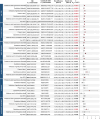Dupilumab shows no elevated risk for maternal adverse pregnancy outcomes: A propensity-matched cohort study
- PMID: 40172175
- PMCID: PMC12376243
- DOI: 10.1111/jdv.20670
Dupilumab shows no elevated risk for maternal adverse pregnancy outcomes: A propensity-matched cohort study
Abstract
Background: Type 2 chronic inflammatory diseases (T2IDs) are highly prevalent among women of reproductive age. Dupilumab, a monoclonal antibody, is increasingly used to treat T2IDs. While dupilumab is not approved during pregnancy, smaller studies suggest no increased risk of pregnancy complications (adverse pregnancy outcomes (APOs)). Additional data are required to better assess the drug's safety during pregnancy.
Objectives: To retrospectively assess the risk of APOs in dupilumab-treated pregnant women in a large real-world database.
Methods: Pregnant women with T2ID and dupilumab treatment during pregnancy were retrieved from the US Collaborative Network of TriNetX. Pregnant women with T2ID and without dupilumab treatment served as controls. Propensity score matching (PSM) for demographics, diagnoses, medications and putative APO risk factors was employed. Outcomes analysed included various maternal pregnancy complications, including premature obstetric labour, pregnancy-induced hypertension, gestational diabetes, puerperal infections and spontaneous abortion. Survival analyses were assessed using the Kaplan-Meier method, outcome differences the log-rank test and hazard ratios (HR) the Cox regression model.
Results: During pregnancy, 293 women were exposed to dupilumab. Following PSM, no increased risks for APOs were noted. Of note, reduced risks for premature obstetric labour (HR: 0.11, confidence interval (CI): 0.03-0.45, p = 0.0002) and 'any APO' (HR: 0.53, CI: 0.33-0.84, p = 0.0067) in the dupilumab-treated group were found. Furthermore, no difference in risks for any APO was noted between dupilumab-treated and untreated women up to 6 months before pregnancy or during the postpartum period.
Conclusions: This large-scale propensity-matched retrospective cohort study suggests a favourable safety profile of dupilumab during pregnancy. Given the difficulties of prospective studies during pregnancy, it provides valuable insights, though further studies are needed to confirm these findings and explore causal relationships.
© 2025 The Author(s). Journal of the European Academy of Dermatology and Venereology published by John Wiley & Sons Ltd on behalf of European Academy of Dermatology and Venereology.
Conflict of interest statement
The authors declare that this study was designed and conducted in the absence of any financial or commercial relationships that could be construed as a potential conflict of interest. SP received support for travel from TriNetX unrelated to the current work. HZ received support for meeting attendance and/or travel from Pfizer, UCB Pharma, Almirall, Janssen and TriNetX unrelated to the current work.
Figures






References
-
- Dierick BJH, van der Molen T, Flokstra‐de Blok BMJ, Muraro A, Postma MJ, Kocks JWH, et al. Burden and socioeconomics of asthma, allergic rhinitis, atopic dermatitis and food allergy. Expert Rev Pharmacoecon Outcomes Res. 2020;20(5):437–453. - PubMed
-
- Harrop J, Chinn S, Verlato G, Olivieri M, Norbäck D, Wjst M, et al. Eczema, atopy and allergen exposure in adults: a population‐based study. Clin Exp Allergy. 2007;37(4):526–535. - PubMed
-
- Balakirski G, Novak N. Atopic dermatitis and pregnancy. J Allergy Clin Immunol. 2022;149(4):1185–1194. - PubMed
MeSH terms
Substances
Grants and funding
LinkOut - more resources
Full Text Sources
Medical
Miscellaneous

